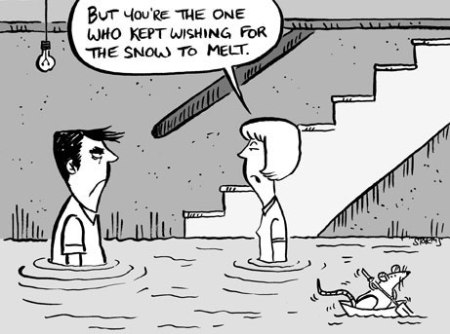
Did you know that homeowners policies typically do not cover damage caused by your wet basement? Excess water is typically caused by surface water running down foundation walls, groundwater, storm sewer water, sanitary sewer water from a clog in a sewer line.
Kind of a major bummer, isn’t it?
Just think of what you’d lose- baby clothes, heirlooms, photo albums… all things it is difficult to put a price on.
Here are a few ways to manage this risk:
1) Add the Sump-Pump Overflow Coverage to your homeowner’s insurance policy.
The Water Back Up/Sump Discharge or Overflow Endorsement insures your direct physical loss to a maximum limit of $5,000.00 (subject to a $250.00 deductible), so long as it is not caused by your negligence. The coverage applies to both your basement and your personal property if damage is caused by water or waterborne material which either backs up through sewers or drains; or overflows/is discharged from a sump or related equipment — even if the discharge occurs due to mechanical breakdown.*
It is a coverage available by request and comes in handy if you’d like to protect that finished basement of yours!
2) Clean your gutters.
Depending on how many trees you have around your house, you may have to clean them a few times per year. Not cleaning your gutters may cause large quantities of surface water to drain and pool down next to the foundation of your home. If this happens regularly and it is not caused by leaves, you should check and see if you have enough downspouts to support adequate draining.
3) Install a perimeter drain system with a sump pump.
The system is built to push groundwater into the drain system and not into areas where it can damage carpets, walls, or personal-belongings. The water drains into a sump pit where a sump pump discharges it out of the house.
*The original exclusion to Water Damage is replaced by the following. Water means: flood, surface water, waves, including tidal wave and tsunami, tides, tidal water, overflow of any body of water, or spray from any of these, all whether or not driven by wind, including storm surge; Water which backs up through sewers or drains; or overfows or is otherwise discharged from a sump pump or related equipment; as a direct or indirect result of flood; Water below the surface of the ground including water which exerts pressure on, or seeps, leaks or flows through a building, sidewalk, driveway, patio, foundation, swimming pool or other structure; or Waterborne material carried or otherwise moved by any of the water referred to in this exclusion. This exclusion applies regardless of whether any of the above is caused by an act of nature or otherwise caused. It applies to, but is not limited to, escape, overflow or discharge, for any reason, of water or waterborne material from a dam, levee, seawall or any other boundary of containment system.
NOTE: This is for informational purposes only and is not necessarily true for all insurance companies. Call your agent for additional information.



 Posted by Liz
Posted by Liz 










